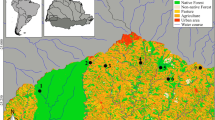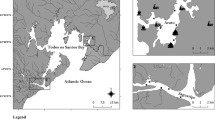Abstract
Historically, the Santos estuary illustrated a scenario of pollution and environmental catastrophes. In 1980, it was called the Vale da Morte (Death Valley), after the public resonance and mitigation measures became a model of environmental recovery. This study aims at assessing the ecosystem health of Santos estuary using Mytella falcata bivalve as bioindicator, and histopathology as biomarker. Bivalves were collected at three sample sites: Site A, located in Branco River with no industrial impact; Sites B, located in Barnabé Island, at the left bank of Santos Port; Site C, located next to Companhia Siderúrgica Paulista, in direct contact with industrial effluents. The collected animals had their gills dissected, fixed, and processed according to the histological routine. The tissue sections were dyed with hematoxylin and eosin to identify morphological changes. To analyze the slides, we used a disorder classification system and frequency index assignment to quantify the disorders observed. For the statistical background, tests of normality and of significant difference among the sample sites were performed. Results showed severe disorders in organisms from Sites B and C, such as tumors; however, the Site B revealed more expressive complications, such as necrosis. In contrast, Site A presented only mild disorders, such as infiltration. By analyzing the results and comparing environmental data, it is possible to affirm that the pollution status on the Santos estuary remains similar to the last histopathology study published, approximately 10 years ago, pointing out high concentrations of contaminants that directly affect the ecosystem and the organisms’ health.

Similar content being viewed by others
Data Availability
The authors confirm that all data generated or analyzed during this study are included in this present article.
References
Bernet, D., Schmidt, H., Meier, W., Burkhardt-Holm, P., & Wahli, T. (1999). Histopathology in fish: Proposal for a protocol to assess aquatic pollution. Journal of Fish Diseases, 22(1), 25–34. https://doi.org/10.1046/j.1365-2761.1999.00134.x
BRASIL. Lei nº 9.966, de 28 de abril de 2000. Dispõe sobre a prevenção, o controle e a fiscalização da poluição causada por lançamento de óleo e outras substâncias nocivas ou perigosas em águas sob jurisdição nacional e dá outras providências. Diário Oficial da União: seção 1, Brasília, DF, ano 137, n. 82-A, p. 1, 29 abr. 2000.
CETESB, Companhia Ambiental do Estado de São Paulo. (2018). 50 anos de história e estórias (p. 102) CETESB.
CETESB, Companhia Ambiental do Estado de São Paulo. (2019a). Qualidade das águas interiores no estado de São Paulo 2019 (p. 366) CETESB.
CETESB, Companhia Ambiental do Estado de São Paulo. (2019b). Qualidade das águas costeiras no estado de São Paulo 2019 (p. 204) CETESB.
CODESP, Companhia Docas Estado de São Paulo. (2006). Plano de Desenvolvimento e Zoneamento (PDZ) do Porto de Santos. Retrieved March 10, 2020, from https://www.gov.br/infraestrutura/pt-br/centrais-de-conteudo/pdz29-pdf
Dang, M., Pittman, K., Sonne, C., Hansson, S., Bach, L., Søndergaard, J., Stride, M., & Nowak, B. (2020). Histological mucous cell quantification and mucosal mapping reveal different aspects of mucous cell responses in gills and skin of shorthorn sculpins (Myoxocephalus scorpius). Fish & Shellfish Immunology, 100, 334–344. https://doi.org/10.1016/j.fsi.2020.03.020
David, J. A. O., & Fontanetti, C. S. (2005). Surface morphology of Mytella falcata gill filaments from three regions of the Santos estuary. Brazilian Journal of Morphological Sciences, 22(4), 203–210.
David, J. A. O., & Fontanetti, C. S. (2009). The role of mucus in Mytella falcata (Orbigny 1842) gills from polluted environments. Water, Air, and Soil Pollution, 203(1–4), 261–266. https://doi.org/10.1007/s11270-009-0009-9
David, J. A. O., Salaroli, R. B., & Fontanetti, C. S. (2008). The significance of changes in Mytella falcata (Orbigny, 1842) gill filaments chronically exposed to polluted environments. Micron, 39, 1293–1299. https://doi.org/10.1016/j.micron.2008.03.001
Ferreira, L. G. 2007. A gestão do pólo industrial de Cubatão a partir do programa de controle da poluição iniciado em 1983: atores, instrumentos e indicadores. 289 f. Dissertação (Mestrado em Saúde Ambiental) – Faculdade de Saúde Pública. Universidade de São Paulo, São Paulo, 2007. https://doi.org/10.11606/D.6.2007.tde-20032008-110106
Ferreira, L.C. (2006). Os fantasmas do vale: conflitos em torno do desastre ambiental de Cubatão, SP. Política & Trabalho, 25, 165-188.
Hinojosa-Garro, D., Osten, J.R.-V., & Dzul-Caamal, R. (2020). Banded tetra (Astyanax aeneus) as bioindicator of trace metals in aquatic ecosystems of the Yucatan Peninsula, Mexico: Experimental biomarkers validation and wild populations biomonitoring. Ecotoxicology and Environmental Safety, 195(1), 1–10. https://doi.org/10.1016/j.ecoenv.2020.110477
Klanovicz, J., Ferreira Filho, C.B. (2018). A fabricação de uma cidade tóxica: a tribuna de santos e os desastres tecnológicos de Cubatão (Brasil) na década de 1980. Revista Cadernos do Ceom, 31(48), 10–20. https://doi.org/10.22562/2018.48.01
Lopes, R. M., Hauser-Davis, R. A., Oliveira, M. M., Pierini, M. F., Souza, C. A. M., Cavalcante, A. L. M., Santos, C. R., Comarð, M. W., & Tinoca, L. A. F. (2020). Principles of problem-based learning for training and professional practice in ecotoxicology. Science of the Total Environment, 702, 1–7. https://doi.org/10.1016/j.scitotenv.2019.134809
Maioli, O. L. G., Rodrigues, K. C., Knoppers, B. A., & Azevedo, D. A. (2010). Polycyclic aromatic and aliphatic hydrocarbons in Mytella charruana, a bivalve mollusk from Mundaú Lagoon, Brazil. Microchemical Journal, 96(1), 172–179. https://doi.org/10.1016/j.microc.2010.03.001
Milaré, É. & Magri, R.V.R. (1992). Cubatão um modelo de desenvolvimento não- sustentável. São Paulo em Perspectiva, 1(6), 99-105.
Pereira Filho, J., Spillere, L.C. & , C.A.F. (2003). Dinâmica de nutrients na região portuária do rio Itajaí-Açu, SC. Atlântica, Rio Grande, 25(1), 11-20.
Pinto, C. S., Cruz, L.S.F. (2020). Patrimônio industrial e o reconhecimento cultural: A vila operária da Companhia Santista de Papel em Cubatão-SP. Paranoá, 25, 56–70. https://doi.org/10.18830/issn.1679-0944.n25.2020.04
Pitteri, S., Bresciani, L. P. (2014). Resiliência regional nas perspectivas teórica e empírica: o caso do Polo Industrial de Cubatão, São Paulo. Revista Brasileira de Gestão e Desenvolvimento Regional, 10(1), 305-335.
Santos Port Authority. (2006). Plano de Desenvolvimento e Zoneamento (PDZ) do Porto de Santos. Retrieved March 10, 2020, from https://www.gov.br/infraestrutura/pt-br/centrais-de-conteudo/pdz29-pdf.
Silva, O.R. & Gomes, M.B.M. (2012). Impactos das Atividades Portuárias no Sistema Estuarino de Santos. Revista Metropolitana de Sustentabilidade, 2(2), 64-81.
Souza, C. D. C. (2016). Capital accumulation process and resilience: Urban planning and redevelopment of port areas, a case study of Santos (Brazil). History - Urbanism – Resilience, 03, 163–173.
Tolian, R., Makhsoosi, A. H., & Bushehri, P. K. (2020). Investigation of heavy metals in the ballast water of ship tanks after and before the implementation of the ballast water convention: Bushehr Port, Persian Gulf. Marine Pollution Bulletin, 157, 111–378. https://doi.org/10.1016/j.marpolbul.2020.111378
Acknowledgements
We thank the CNPq that provided a scholarship during 2018–2019 to carry out the scientific initiation project that culminated in the preparation of the present article.
Funding
The present study was supported by the Conselho Nacional de Desenvolvimento Científico e Tecnológico (CNPq) with a scientific initiation scholarship.
Author information
Authors and Affiliations
Contributions
Maristela Cassita: conceptualization, methodology, analysis, writing (first manuscript, review, and editing), funding acquisition. José David: supervision, conceptualization, methodology, analysis, writing (review and editing), funding acquisition. All authors read, reviewed, and approved the final manuscript.
Corresponding author
Ethics declarations
Conflict of Interest
The authors declare no competing interests.
Additional information
Publisher's Note
Springer Nature remains neutral with regard to jurisdictional claims in published maps and institutional affiliations.
Rights and permissions
About this article
Cite this article
Cassita, M.L.C., de Oliveira David, J.A. Historical Analysis of Environmental Pollution in Santos Estuary: Histological Study of Mytella falcata (Orbigny, 1846) Gills as Bioindicator. Water Air Soil Pollut 233, 95 (2022). https://doi.org/10.1007/s11270-022-05525-9
Received:
Accepted:
Published:
DOI: https://doi.org/10.1007/s11270-022-05525-9




